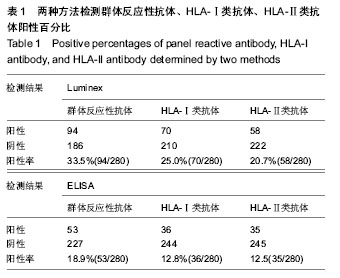| [1] 武俊杰,贾保祥,田野.初次等待肾移植患者产生群体反应性抗体的因素分析[J].中国组织工程研究与临床康复,2011,15(44): 8225-8227.[2] Vaidya S.Synthesis of new and memory HLA antibodies from acute and chronic rejections versus pregnancies and blood transfusions.Transplant Proc. 2005;37(2):648-649.[3] 李晓北,张小东.肾移植术后抗HLA抗体的检测[J].国际移植与血液净化杂志,2007,5(6):26-29.[4] Zhang Q, Liang LW, Gjertson DW,et al.Development of posttransplant antidonor HLA antibodies is associated with acute humoral rejection and early graft dysfunction. Transplantation. 2005;79(5):591-598.[5] Mihaylova A, Baltadjieva D, Boneva P,et al.Clinical relevance of anti-HLA antibodies detected by flow-cytometry bead-based assays--single-center experience.Hum Immunol. 2006;67(10):787-794.[6] Panigrahi A, Deka R, Bhowmik D,et al.Functional assessment of immune markers of graft rejection: a comprehensive study in live-related donor renal transplantation.Clin Transplant. 2006;20(1):85-90.[7] Morales-Buenrostro LE, Buzo-Romero JM, de Leo C,et al.Prevalence of HLA antibodies and its impact on graft function in a group of kidney transplant recipients: a cross-sectional study.Transplant Proc. 2006;38(3):899-902.[8] Lenaers J, Christiaans M, van Heurn E,et al.Frequent but late donor-directed antibody formation after kidney transplantectomy within one month after grafting. Transplantation. 2006;81(4):614-619.[9] Terasaki PI, Ozawa M.Predicting kidney graft failure by HLA antibodies: a prospective trial.Am J Transplant. 2004; 4(3): 438-443.[10] Worthington JE, Martin S, Al-Husseini DM,et al. Posttransplantation production of donor HLA-specific antibodies as a predictor of renal transplant outcome. Transplantation. 2003;75(7):1034-1040.[11] Hourmant M, Cesbron-Gautier A, Terasaki PI,et al.Frequency and clinical implications of development of donor-specific and non-donor-specific HLA antibodies after kidney transplantation.J Am Soc Nephrol. 2005;16(9): 2804-2812.[12] 王庆华,谭建明,王英,等.HLA配型对群体反应性抗体阳性的肾移植受者人/肾存活率的影响[J].中华器官移植杂志,2007, 28(12): 728-730.[13] Han F, Lv R, Jin J,et al.Pre-transplant serum concentrations of anti-endothelial cell antibody in panel reactive antibody negative renal recipients and its impact on acute rejection.Clin Chem Lab Med. 2009;47(10): 1265-1269. [14] Li X, Ishida H, Yamaguchi Y,et al.Poor graft outcome in recipients with de novo donor-specific anti-HLA antibodies after living related kidney transplantation.Transpl Int. 2008; 21(12):1145-1152.[15] 朱鹏,李建远.液态芯片的原理及其在临床诊断中的应用[J].中国保健营养,2013,23(4):2150-2151.[16] Terasaki PI.Humoral theory of transplantation.Am J Transplant. 2003;3(6):665-673.[17] 王庆华,尚乐乐,唐敏英,等.Luminex技术与ELISA方法检测抗HLA抗体在肾移植急性排斥反应中的应用[J].中华器官移植杂志,2013,34(8):455-457.[18] Lefaucheur C, Suberbielle-Boissel C, Hill GS, et al.Clinical relevance of preformed HLA donor-specific antibodies in kidney transplantation.Am J Transplant. 2008;8(2):324-331. [19] 孙启全.肾移植致敏受者处理措施的选择[J].肾脏病与透析肾移植杂志,2006,15(6):538-539.[20] 石炳毅.应进一步提高肾脏移植排斥反应的无创诊断水平[J].中华医学杂志,2011,91(48):3385-3387.[21] Lucas DP, Paparounis ML, Myers L,et al.Detection of HLA class I-specific antibodies by the QuikScreen enzyme-linked immunosorbent assay.Clin Diagn Lab Immunol. 1997;4(3): 252-257.[22] Bay JT, Garred P. Rapid bead-based immunoassay for measurement of mannose-binding lectin.Scand J Immunol. 2009;69(6):570-575.[23] Arellano-Garcia ME, Hu S, Wang J,et al.Multiplexed immunobead-based assay for detection of oral cancer protein biomarkers in saliva.Oral Dis. 2008;14(8):705-712. [24] Livingston AD, Campbell CJ, Wagner EK,et al. Biochip sensors for the rapid and sensitive detection of viral disease. Genome Biol. 2005;6(6):112.[25] Linkov F, Yurkovetsky Z, Lokshin A.Hormones as biomarkers: practical guide to utilizing luminex technologies for biomarker research.Methods Mol Biol. 2009;520:129-141.[26] Bortolin S, Black M, Modi H,et al.Analytical validation of the tag-it high-throughput microsphere-based universal array genotyping platform: application to the multiplex detection of a panel of thrombophilia-associated single-nucleotide polymorphisms.Clin Chem. 2004;50(11):2028-2036. [27] Nolan JP, Sklar LA.Suspension array technology: evolution of the flat-array paradigm.Trends Biotechnol. 2002;20(1):9-12.[28] Beske OE, Goldbard S. High-throughput cell analysis using multiplexed array technologies.Drug Discov Today. 2002;7(18 Suppl):S131-135.[29] Oliver KG, Kettman JR, Fulton RJ.Multiplexed analysis of human cytokines by use of the FlowMetrix system.Clin Chem. 1998;44(9):2057-2060. [30] 何英,陆学东.液相芯片技术及其临床应用[J].国际检验医学杂志, 2006,27(12):1107-1108,1111.[31] 陈玮.液相芯片技术的原理与应用进展[J].成都医学院学报,2008, 3(3):225-230.[32] 谢冲,王国民.Luminex液相芯片的发展及应用[J].复旦学报:医学版,2010,37(2):241-244.[33] Edwards BS, Oprea T, Prossnitz ER,et al. Flow cytometry for high-throughput, high-content screening.Curr Opin Chem Biol. 2004;8(4):392-398.[34] Martins TB. Development of internal controls for the Luminex instrument as part of a multiplex seven-analyte viral respiratory antibody profile. Clin Diagn Lab Immunol. 2002;9(1):41-45.[35] Biagini RE, Sammons DL, Smith JP, et al.Comparison of a multiplexed fluorescent covalent microsphere immunoassay and an enzyme-linked immunosorbent assay for measurement of human immunoglobulin G antibodies to anthrax toxins.Clin Diagn Lab Immunol. 2004;11(1):50-55.[36] Pickering JW, Martins TB, Schroder MC,et al.Comparison of a multiplex flow cytometric assay with enzyme-linked immunosorbent assay for auantitation of antibodies to tetanus, diphtheria, and Haemophilus influenzae Type b.Clin Diagn Lab Immunol. 2002;9(4):872-886.[37] de Jager W, te Velthuis H, Prakken BJ,et al.Simultaneous detection of 15 human cytokines in a single sample of stimulated peripheral blood mononuclear cells.Clin Diagn Lab Immunol. 2003;10(1):133-139.[38] Flagella M, Bui S, Zheng Z,et al. A multiplex branched DNA assay for parallel quantitative gene expression profiling.Anal Biochem. 2006;352(1):50-60.[39] Hessner MJ, Budish MA, Friedman KD.Genotyping of factor V G1691A (Leiden) without the use of PCR by invasive cleavage of oligonucleotide probes.Clin Chem. 2000;46(8 Pt 1):1051-1056.[40] Martin L, Guignier F, Bocrie O,et al.Detection of anti-HLA antibodies with flow cytometry in needle core biopsies of renal transplants recipients with chronic allograft nephropathy.Transplantation. 2005;79(10):1459-1461.[41] Beekley AC, Blackbourne LH, Sebesta JA,et al.Selective nonoperative management of penetrating torso injury from combat fragmentation wounds.J Trauma. 2008;64(2 Suppl): S108-116.[42] Muro M, Llorente S, Marín L,et al. Acute vascular rejection mediated by HLA antibodies in a cadaveric kidney recipient: discrepancies between FlowPRA, ELISA and CDC vs luminex screening.Nephrol Dial Transplant. 2005;20(1):223-226.[43] Lucas DP, Paparounis ML, Myers L,et al.Detection of HLA class I-specific antibodies by the QuikScreen enzyme-linked immunosorbent assay.Clin Diagn Lab Immunol. 1997;4(3): 252-257.[44] 王庆华,尚乐乐,唐敏英,等.Luminex技术与ELISA方法检测抗HLA抗体在肾移植急性排斥反应中的应用[J].中华器官移植杂志,2013,34(8):455-457.[45] 贾保祥,马威然,田野.再次肾移植患者HLA与PRA的关系研究[J].国际检验医学杂志,2012,33(17):2060-2061,2064.[46] Singh N, Djamali A, Lorentzen D,et al.Pretransplant donor-specific antibodies detected by single-antigen bead flow cytometry are associated with inferior kidney transplant outcomes.Transplantation. 2010;90(10):1079-1084. [47] Haririan A, Nogueira J, Kukuruga D,et al.Positive cross-match living donor kidney transplantation: longer-term outcomes.Am J Transplant. 2009;9(3):536-542. [48] 傅茜,王长希,陈立中,等.66例亲属活体肾移植的临床观察[J].肾脏病与透析肾移植杂志,2008,17(1):9-13.[49] Gibney EM, Cagle LR, Freed B,et al.Detection of donor-specific antibodies using HLA-coated microspheres: another tool for kidney transplant risk stratification.Nephrol Dial Transplant. 2006;21(9):2625-2629. [50] 张保强,张晓.Luminex液态芯片在临床及科研中的应用[J].当代医学,2012,18(4):18-20. |


.jpg)